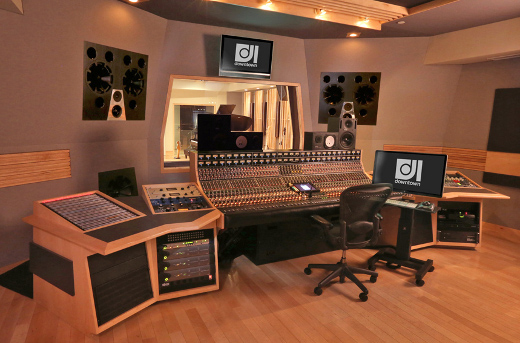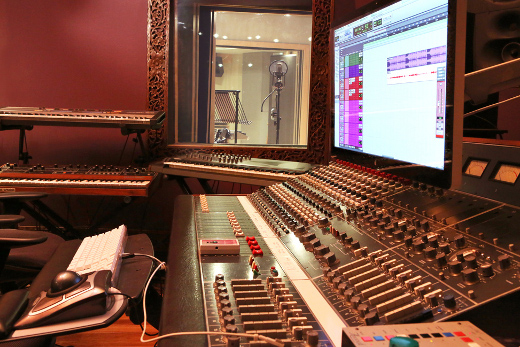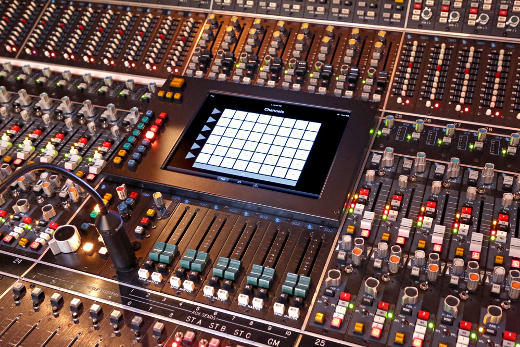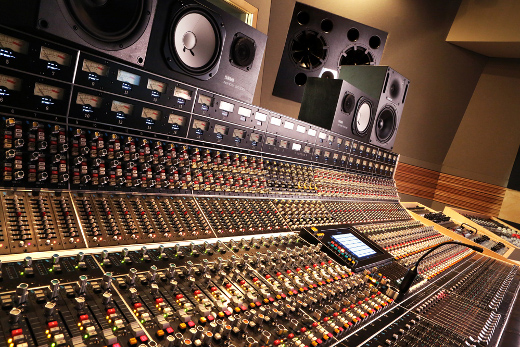The API and the iPad: Radical Routing Arrives at Downtown Music Studios
SOHO, MANHATTAN: Convergence comes in all forms, and no one knows that more than music creators: Whether you’re talking Hassidic hip hop, Danger Mouse + Norah Jones, Okinawan trance, or Tony Bennett crooning with Lady Gaga, what gets us excited is the previously unthinkable combination – made real and amazing.
The same holds true for gear, and just such a convergence has happened at Downtown Music Studios. Enter the SoHo facility’s Studio A, and inside you’ll see a most surprising sight: a vintage 48-channel API Discrete Console…with an iPad sitting smack in the center section, capable of controlling its every routing maneuver.
As you can imagine, marrying the massive machine with Apple’s touch tablet didn’t happen overnight. Nor was this distinctive analog/digital setup the original intention of the driven engineering team at Downtown. But when curiosity, determination, patience, and a commitment to better audio — you know — converge, that’s when unexpected evolutions happen.

A 48-channel API Discrete Console — with an unusual centerpiece — is now featured in Downtown’s Studio A. (all photos by Robert Adam Mayer)
An Unexpected Switch
Just two years ago, Downtown’s Chief Engineer, Zach Hancock, had overseen a big-time install in the open and airy, Pilchner-Schoustal-designed Studio A, with the implementation of a vintage Neve 8014 console there. Things had been going swimmingly with the Neve, which handled hundreds of sessions for clients including Dr. Luke, Benny Blanco, and Mark Ronson, and the 16-channel board born in 1970 looked set for life.
What sent things spinning into fresh directions was Hancock’s need to find an analog board for Downtown’s Studio B. A more intimate, Digidesign D-Command-equipped room, B’s Bali-at-midnight vibe had attracted its own dedicated fanbase. “Our clients are losing interest in control surfaces, and are excited about analog consoles with lots of vibe,” says Hancock. “We had never contemplated replacing the Neve in the ‘A’ room, I actually started looking for a board to replace our aging D-command in ‘B’. Up turned this API: It’s one of the best sounding-desks I’ve ever heard, but it made more sense from a workflow standpoint in Studio ‘A’ than ‘B’.
“So the concept shifted towards moving the Neve from Studio A into Studio B,” continues Hancock, “while dropping the API into Studio A. The Neve had been such a huge success, that at first the idea wasn’t an easy sell. I put together a thorough cost analysis, while we vetted the console to make sure it was mechanically all together. Once it checked out, I put together a P&L for studio A with the API in it, and presented it to the guys at Downtown. As luck would have it, everything came together.”
Complicated Changeup
Of course, luck only had a small part to do with what’s making Downtown’s API an essential experience, both in terms of listening and workflow, for producers, engineers, and artists.
Once the plan had been approved at Downtown — which has the considerable additional resources of the successful Downtown Music Publishing and Downtown Records entities in the fold — Hancock and his team set out on a complicated six-month journey. In the process, they would arrive at a highly original solution to make the most out of their special board.
The API that was inspiring all of this activity had been acquired from the famed Kooster McAllister, proprietor of Ringwood, NJ’s Record Plant Remote mobile recording provider. “The most important thing I can say about this console is that it has a 100% discrete analog signal path – this is not a digital console,” Hancock emphasizes. “The first thing clients take away from it is how it sounds. It’s an exceptionally musical recording console – I have not personally worked on a better-sounding board.”
Downtown procured the late-1980’s API Discrete Console with its original computer-controlled routing system intact. But Hancock recognized that there was no vintage charm attached to that particular component, an eighties-era computer similar to what had been employed in early ATM machines.
“The original computer was a marvel of engineering for its time,” says Hancock. “It used a custom UI to convert user commands into the control voltages needed to actuate the gas-filled relays that handle the analog signal path. My iPhone does 5 billion times what that computer is capable of. So the question was, ‘How do we shrink the computer’s footprint, expand on what it does, and take it from 1989 into 2013?’”
Console Control Reimagined
Hancock collaborated closely with Joe Russo of Russo Audio Design, who had been instrumental in vetting and procuring both the Neve and API for Downtown, to navigate the next phase’s uncharted waters. The 10,000-ft objective: transform the digital routing matrix into an extremely efficient process for routing the console’s inputs and outputs.
“There were many factors influencing our decision to redesign the existing system,” says Russo. “My priority was the underlying notion that the old computer was something we couldn’t repair if broken. It used custom interface cards, and the proprietary software had no original source-code.”
This meant finding a way to make a new touch surface seamlessly interact with nearly 4,000 relays inside “The Coffin”, Downtown’s nickname for the large box holding the API’s 48 individual 48×48 routing circuit boards. “I sat down with relay cards and began tracing the circuit,” Russo says, “making schematics as I went, and referencing the documents from the original design for clues. Once I had things on paper, I had a better idea of what needed to happen from a hardware perspective.”
That’s when Downtown’s deep resources – in human terms – came into play. Hancock and Russo discovered that the programming expert that would be needed to steer this unprecedented transformation could be found in-house, in the form of Edward Dias III. The lead software developer at SongTrust, an innovative online royalty collection service owned by Downtown, Dias understood the unique challenges of the API project and was prepared to help solve them.
“Zach and Joe felt that if they could update the board’s technology, they’d get the best of both worlds: a beautiful analog console combined with the flexibility of a digital routing system,” Dias explains. “It became obvious we would have to build something new to accomplish that. In order to get there, we had to reverse-engineer all of the console’s subsystems: The I/O and buss routing subsystems are all on similar boards, but are separate units from the console itself and operate in different ways.
“We mocked up a prototype with a simple Arduino microcontroller and the associated components to connect directly to the console’s data buss,” Russo adds. “At this stage, it was a dummy system whereby we could try to do things with the relay cards on the workbench. This microcontroller would eventually serve as our hardware interface, a sort of hidden backend that seamlessly marries the user interface to the console.
“We analyzed the data/logic signals coming out of the original digital routing computer, subsystem by subsystem, to build up proof-of-concepts which would then be made into programs. Once we had every subsystem coded out, we were able to integrate those programs into a higher-level program that managed everything. Then we started to go into the control surface phase.”
Providing a high-functioning touch screen with easy replaceability, the iPad quickly emerged as the control surface of choice for the API. Once conjoined with the console, its mission would be to disseminate the engineer’s commands to the embedded microcontroller, which would subsequently guide the appropriate relays within the routing subsystems to action. “We wrote thousands of lines of low-level code to flip all the switches,” notes Dias. “None of us were sure how it would all pan out.”
Go Open-Source, Not Exclusive
iPad control of various digital console products is starting to emerge on the market, but retrofitting it on an all-discrete analog console is another proposition entirely. With no known precedents to refer to, it’s understandable that Dias and Russo would maintain cautious optimism throughout the months-long process.
“When Joe and I recorded the data from the old computer, we would learn what signal needed to happen to accomplish one single task,” Dias says. “We could simulate that on a small scale. But to get it to run as a real program, performing all these multiple functions, took a lot of time.”
As much as possible, Dias and Russo leveraged open-source hardware and software and the online community. “Fortunately, we were able to find platforms with great community support that were easily acquired, and not locked into any licensing schemes,” Dias explains. “That’s a big reason why we went with iOS and the iPad for the actual interface and Arduino for the microcontroller.
“The gist is that if a microcontroller breaks down, an engineer can run to Radio Shack and plug a new one in. If the iPad goes, run to the Apple Store. The thinking was, ‘Get hardware and software components that you can source easily, instead of having to chase down an aging engineer that last worked on the system 15 years ago.’”
For Dias, his role presented the opportunity to forge a new connection between hardware and software. “That’s why this project drew me in,” he confirms. “It’s bridging together contemporary digital technologies with one-of-a-kind, amazing-sounding analog gear that you really can’t replicate right now.”
Meet Your Meters
As the Downtown team worked to make the iPad and API play nice, Hancock had his eye on another significant improvement: adding input meters, which the board had lacked up to this point.
But that modification carried its own additional complexities. “This is a tall console,” observes Hancock, “and the thing about console height is it determines monitoring height, which is critical to your studio’s performance. The challenge was to add input metering, while displaying your i/o assignments on a per-channel scale, but to do it in a small form factor.”
After multiple trips to the drawing board, and a few prototypes, Russo and Hancock landed on the solution: Two vertically stacked VU meters, each accompanied by a paper-thin, high-resolution OLED screen that displays all the vital information for confirming channel settings.
“Being so thin, we were able to machine them right into the metal and take advantage of otherwise dead space between the meters,” Russo says. “They display everything you need to know about each channel. It’s all real – the displays are monitoring what’s actually happening, not just being told what a computer thinks is happening.”
A New Wrinkle for Analog Audio + Digital
What this convergence comes back down to is the sonics. Of course, Downtown’s commodious live room is right there for tracking and overdubs. And now, combined with a powerful new set of custom Martin Pilchner-designed main monitors, the API Discrete Console puts mixers in one of the sweetest sweet spots in NYC.
“The first thing is it’s an API,” Hancock says. “So it has a lot of saturation from the discreet op amps – the 2520’s and the 2510’s. It has a beautiful sound, with an elegance to it because it’s not overbearing. It’s a really musical mic pre, and just an exceptional-sounding mixbus.
“The way the digital technology comes into play here is it makes routing fast, efficient, and recallable. Its also simple: Anyone can step in front of this and learn the board’s routing in a few moments. If you’re a professional engineer, you’ll get it right away.”
Fully installed in Studio A since November, the API has already tracked sessions for luminaries such as Vampire Weekend, and – more than a year after Hancock fell in love at first listen – no longer represents a work in progress. Rather, this highly evolved hybrid board is vying to set a fresh benchmark in the intensely competitive NYC studio scene.
“I admire what a lot of the facilities are doing here in town, but it’s important for us not to do the same thing as anyone else in the community,” states Hancock. “This is something unique, exceptional, and special for the market, which is synonymous with the Downtown brand. Without boards like this, people are just working in the box. We wanted to offer the best excuse we could to step beyond that.”
— David Weiss
Please note: When you buy products through links on this page, we may earn an affiliate commission.










Kooster
January 7, 2013 at 4:59 pm (11 years ago)I know my console is in good hands. The original touch screen was able to do more than the I-pad does now but they are running V1 software with more goodies to be added down the road. The fact that the console had a touch screen so many years ago when it was commissioned on the Record Plant Remote mobile is a testament to how advanced the API was for it’s time. Once again the genius of Paul Wolff is on display.
Kooster
TrustMeI'mAScientist
January 8, 2013 at 9:05 am (11 years ago)Very cool. And practical too.